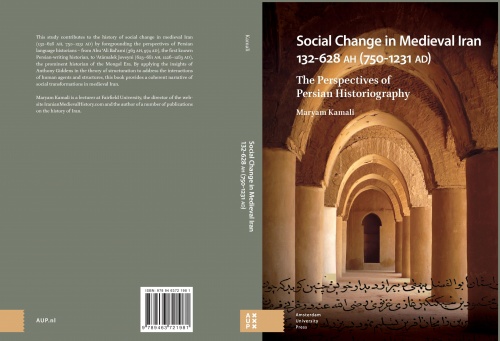Social Change in Medieval Iran 132-628 AH (750-1231 AD) The Perspectives of Persian Historiography is a detailed interdisciplinary study that uses a sociological framework to delve into first-hand historical books in the Persian language. By providing novel perspectives, this book examines medieval Iran's history, from the rise of Iranian dynasties to their fall by the Mongols. The introduction of the book begins with introducing the characteristics of Persian language historiography and Giddens’ theory of Struturation used as a theoretical framework in this research. It follows how this sociological theory, founded on the interaction of agents and structures in social changes, can be applied to historical events. Also, it explains how power, structure, and agent as three components of social change are described in the context of time and space.
This book is about social change and not social history. Therefore, it is a sociological look at historical trends in relation to power and its components. One of the most significant parts of this introduction is the review of the sources cited in the book. This is a reliable list for future research on medieval Iran. It includes the most relevant books about medieval Iran's history in Persian. A critical analysis of these sources explains sociological analysis strategies. This section lists first-hand books about medieval Iran translated into English. Such a list has not yet been compiled. Also, many significant parts of these first-hand books in the Persian language have been translated into English by the author. For example, many aspects of Tarikhnama by Balami, which have not been translated into English, can be accessed by researchers in this language.
The first chapter examines the structures and actors in the establishment of the Abbasid caliphate. It analyzes first-hand sources such as Balami's history reflecting social changes of that time. The function of structures such as Da'wa and Imamate and the actions of activists such as Barmakian and Abu Muslim are analyzed in this section.
The second chapter examines the formation of the first Iranian dynasties, from the Taherids to the Buyids. First, the rise of the Taherids in the shadow of the Abbasid caliphate is analyzed. Then the process of social changes during the Samanid period is discussed in developments such as the revival of Iran's national culture. Challenging the power of the Abbasid caliphate and establishing the Iranian government's complete independence is a significant part of the social changes of the Saffarid dynasty.
The second chapter also examines the Alawid dynasty, a local government in northern Iran. This area stood against Arab Muslim invasions and was not yet converted to Islam and followed the Zoroastrian religion. However, by inviting Shiite agents to rule, became the first Shiite dynasty in Iran. From the perspective of books such as Tarikh-e Tabaristan by Ibn Esfandiar, this chapter examines the social changes of Tabarestan and how the same people who invited Alawids to be their rulers were suppressed. The last section of chapter two studies the structures and agents of the Buyids. It also studies how they maintained the Abbasid caliphate structure despite conquering their capital Baghdad.
The third chapter examines the Soltanate of the Ghaznavid, Saljuq, and Khwarazmshahi with the analysis of very significant first-hand sources such as Tarikh-e Beyhaqi and Saljuqnama. A new perspective is presented by examining important agents such as Iranian bureaucrats and military men, as well as the Ismailis and Fatimid governments. In the following, it has been tried to sociologically and historiographically analyze the causes of the terrible Mongol invasion and their conquest of Iran.
The conclusion at the end of the book emphasizes the continuity and sequence of social changes in medieval Iran. It also emphasizes the reproduction of dynastic structures and actors. The book's conclusion emphasizes the continuity and sequence of social changes in medieval Iran. It also emphasizes the reproduction of dynastic structures and actors.
The complex context of sociological theories often creates difficulty in the general understanding of applied concepts in sociological theoretical frameworks. But the author of this book has tried to use a theoretical framework to open up a horizon in the understanding of historical events. This does not make the text difficult to understand while harmonizing and simplifying it. In keeping with the historical process and using simple narration, the book goes beyond academic scholarship. It can appeal to a general audience as well.
The cover image shows the sequence of arcs towards darkness or light, as if the readers of Persian historiography, including Tarikh-e Beyhaqi are passing through. The smart choice of Tarikhana, which transformed from a fire temple to a mosque, shows the social changes of Iran in medieval times. The book Social Change in Medieval Iran 132-628 AH (750-1231 AD) The Perspectives of Persian Historiography written by Maryam Kamali, which was published by Amsterdam University Press in 2023, is now available to interested readers.
Habib Hajiheidari

